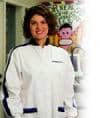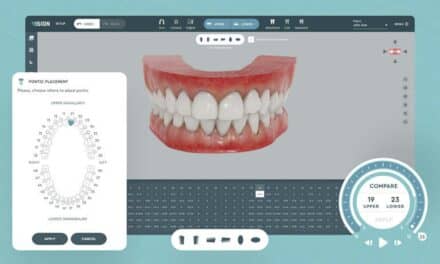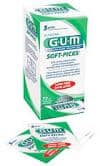by Rich Smith
An orthodontist’s charitable donations make her practice a cherished part of the community
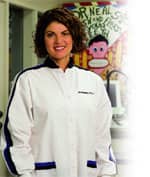
That’s not all, though. If patients want, they can exchange some or all of their pretend money for donations to local charities and community service organizations. Neal marvels at how many happily forego the chance to spend every last credit on themselves to have something left over to benefit others. In fact, she says, quite a few of her patients take the opposite approach, working hard at being treatment compliant for the express purpose of maximizing the amount of scrip they can earn and then give away.
In the course of all this, Neal is not only doing her young patients a favor by inculcating good habits that will serve them well throughout their lifetimes, she’s also deepening her already strong ties to the community—ties that ultimately benefit her practice.
Teaching Kids to Give
The scrip she hands out to her patients are known as Neal Notes. They come in denominations of ones, fives, and 10s, and are roughly the size of Monopoly® money. In the spot where George Washington would appear on a real $1 bill, each Neal Note features an oval-framed photo of Neal clutching models of perfectly aligned teeth.
“I like this as an incentive because it really motivates the kids and teaches them good habits of delayed gratification and saving money,” she says.
The way she has structured the program, a patient can earn up to five Neal Notes in any one visit for satisfying all the compliance-oriented provisos. However, patients can secure more Neal Notes by improving their grades at school or by getting involved in community service projects.
“Recently, for example, one of my patients made fleece blankets and donated them to a child welfare organization, while another patient participated in a school cleanup and bulb-planting, and someone else donated cuttings of her hair to a group called Locks of Love that makes wigs for children who lose their own hair as a result of various medical conditions,” Neal reports.
Meanwhile, Neal does her part to make it easier for patients to become community supporters. Each year, she chooses a charitable organization to which patients can donate their Neal Notes, which Neal first converts to legal tender before distributing to the designated nonprofit. In 2003 and 2004, she picked Polio Plus, an entity set up 20 years ago by Rotary International to help protect children worldwide from polio; she donated roughly $1,600 on behalf of her patients to the cause. The year prior, they chipped in the Neal Note equivalent of $675 to Operation Smile. And, following the September 11 terrorist attack on the World Trade Center in New York, the kids sent $450 to the American Red Cross.
“For the two or three months after September 11, I don’t think any patients hung onto their Neal Notes,” she says. “They turned them all in for donation.”
Neal comes by her sense of community activism almost congenitally. “My mother and father taught by example. They were always active in church and in local affairs,” says Neal, who hails from the town of Slidell, La, just outside New Orleans.
Some of her involvement with nonprofits today comes as a result of a desire to associate with like-minded people of good will. In other instances, it’s by invitation, such as the time an assistant in her office whose daughter played soccer persuaded Neal to volunteer as a coach for the little girl’s team.
Ask Neal to name the civic activity in which she feels her participation made the greatest difference and, without hesitation, she points to her work with the Kirkland Rotary Club to provide meal baskets for the town’s impoverished at Thanksgiving and gifts for needy families at Christmas. “Extremely gratifying,” she says of the experience. “Just to see the thrilled expressions on the faces of the families when we showed up at their doors with our offerings was the absolute greatest.”
Southern Hospitality in the Pacific Northwest
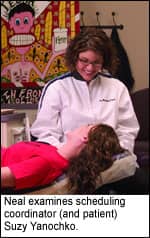
Those T’s, incidentally, were designed by patients whose proposals beat out all the others in a competition held at the practice. Indeed, contests of one sort or another are a regular feature of Neal’s practice. For starters, there’s a quarterly cleaning-card drawing in which patients (and referring dentists’ dental hygienists) can win free movie tickets. Then, in October, patients vie to correctly guess the weight of a small pumpkin on display at the front counter. A recent postcard design contest solicited entries in the categories of Most Original, Most Humorous and Card Received From Farthest Away. During the spring, there’s a coloring contest in which submissions are judged in the categories of Most Original, Most Creative and, of course, Most Colorful.
Not surprisingly, Neal describes her practice as energetic and fun, but adds that it’s also patient-centered and evidence-based.
“Our goal is to provide the highest level of orthodontic treatment possible in a caring, friendly environment,” she says.
Configured in an open-bay floor plan, Neal’s office is decorated with the trappings of Louisiana as her way of sharing with Pacific Northwesterners all the good things for which the Creole State is famous. Thus, along the walls are Folk Art from a New Orleans artist and photographs of the city. The furniture in the waiting room is made of wrought iron, and French fleur-de-lis insignia are everywhere. Mardi Gras is celebrated, of course. Younger patients participate in mask-making contests and traditional Fat Tuesday bead giveaways, and a few years back Neal hosted a Mardi Gras ball for her referring dentists.
Neal is aided in her practice by four full-time and two part-time clinical and administrative staffers, women all and every one of them exceptionally creative, she says.
The office is open Monday through Thursday, 8 am to 5 pm. Neal can get by on a four-day week (seeing patients on three of those) because hers is a very efficiently run operation.
To an extent, she prefers a short week because, less than a year ago, Neal became a first-time mother.
“One of the reasons I chose dentistry, and orthodontics in particular, is that it enables me to continue to have a successful practice and to keep my family my first priority,” she says. “Keeping the practice efficient has afforded me the opportunity to see as many patients on the three days as I did when I worked four, and there is still room to grow.”
When she was pregnant with little Collin Edward, Neal worked until a week before he was due. It was, of course, difficult to do. To make things easier on herself (and her back muscles), she switched from direct to indirect bonding.
After the baby’s arrival, Neal was at home with the baby for about two months. The office remained open, and patients were served during that period by a locum tenens she’d recruited, a retired local orthodontist.
“I wasn’t entirely out of the loop,” she admits. “I accessed the office computer from home through a virtual-private network and kept tabs on cases as necessary.”
Still, motherhood has changed Neal’s views about what is and isn’t important.
“While I was taking maternity leave, I learned to worry a lot less about the office,” she says. “When I returned, I didn’t feel as if I had to micromanage everything.”
Portrait of the Orthodontist as a Young Woman
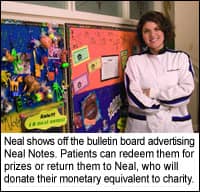
During the summer after she graduated from high school, Neal landed a part-time job in a dental office. She continued to work there during school breaks at college, Louisiana State University. The periodontist cousin who was the subject of that Career Day profile some years prior had by then gotten married—to an orthodontist. It wasn’t long before Neal began hearing from her cousin about how fun and satisfying her orthodontist husband found his job to be. That convinced Neal that she ought to make orthodontics her specialty.
“Orthodontics fit my personality the best of any dental specialty,” she says. “It is a great blend of art and science. I love developing relationships with families and giving people the gift of a beautiful smile.”
Neal graduated at the top of her LSU dental-school class and received a number of awards for academic achievement, including the Chancellor’s Award for most outstanding student. She was also inducted into the Omicron Kappa Upsilon honorary fraternity and was president of the C. Edmund Kells Honor Society. During her orthodontic training, she served on the craniofacial anomaly/cleft lip-and-palate team at LSU’s Children’s Hospital.
She ended up in Washington state because her husband came from Seattle. She and Craig Neal, DDS, MD, met when he came to LSU for medical school and oral surgery training. A mutual friend introduced them; the two hit it off immediately, finding mutual interests in hiking, mountain biking, and snow skiing. They wed while still in school.
It so happened that Michelle Neal completed her training about a year before Craig Neal. In the interim, she moved to Kirkland, not far from Seattle, to start her practice while waiting to be reunited with her husband.
“Straight out of school I purchased a practice,” she says. “I bought it outright, because I didn’t want to be in a situation where I’d work as an associate for a half a year or longer, only to discover the owner had changed his mind about turning the practice over to me.”
Neal contends that many young orthodontists entering practice as associates rather than as practice owners set themselves up for needless anxiety and dissatisfaction.
“Many associateships fail due to unclear contracts and communication between the associate and the owner of the practice at the start of the relationship,” she offers. “Having clear and consistent goals that are shared by both parties gives the arrangement a better chance of succeeding. I wanted to eliminate the possibility of a damaged relationship with immediate ownership and a relatively short transition.”
By agreement, the seller of the practice Neal acquired—Richard (Dick) Westin, DDS—continued to work in the office as Neal’s employee for a transition period of six months.
“Dr Westin was incredible,” she says. “The day I walked into the practice, he had his office ready for me to take over. Retiring was his goal, so we were both meeting our goals with the arrangement. He was a great mentor, and he gave me wonderful advice.”
As to being a woman orthodontist, Neal eschews portraying herself as a member of the opposite sex crashing the gates of what once was a field dominated by men.
“In this day and age, in this wonderful country of ours, anyone with the drive and desire to succeed in orthodontics can do so,” she proffers. “I’m a woman, but I’ve never expected special treatment because of that.”
If she caused eyebrows to raise at all upon her entrance to practice, it was because of her age, she says.
“I was fresh out of school,” Neal says, a petite woman. “In contrast to Dr Westin, who was tall and 64 years old, I looked really young. I tried to make myself look older by wearing suits. When that didn’t work, I switched to a white lab jacket.”
The comments about her youthful appearance subsided; 5 years older now, she’s starting to miss those remarks.
“Maybe I need to go back to wearing the suits,” she jokes.
A Happy, High-Tech Office
Neal didn’t immediately start changing things once she became the new owner.
“The first three months, I busied myself mainly with paperwork,” she recalls. “I was trying to learn everything and anything I could about the business side of orthodontic practice, the things they don’t have time to teach you in school. Dr Westin would treat the patients and introduce me to them. We would work up cases together, which gave me more confidence in my treatment-planning ability.”
After that, she turned her attention to redecorating. The motif at the time was baseball.
“Most people spend more time in their practice than in their home, so it’s important to make it your own,” she says. “I changed the look quickly, but was careful not to alienate Dr Westin’s old patients in the process. Actually, it was pretty hard to alienate them, since Dr Westin was such an enthusiastic cheerleader for me.”
In addition to giving the office the look of New Orleans, she also installed several new pieces of high-tech equipment. The practice came with a computerized patient-management system, but it had been underutilized. Neal soon had it—and a new digital imaging system—working at their full potential. She also deployed computer terminals at every chair.
Thanks to these innovations and her Web site, www.nealsmiles.com, Neal says, “We’re almost entirely paperless today. Patients are emailed appointment reminders. They can even make payments online.”
Then there’s external marketing. Neal prefers to focus on strengthening her ties to local referring dentists because they are where a large percentage of her new patients come from. Accordingly, she frequently hosts noontime “lunch-and-learn” sessions for both the dentists and the dental hygienists.
“They learn a lot from us, but we also learn from them—for example, how to more successfully clean around braces,” she says. “It’s a lot of fun bringing the dental community together in this way.”
Husband Craig Neal is among her referral sources, although she typically sends far more to him than he to she.
“I refer to him my patients who need extractions, implants, and jaw surgery, and whose dentists do not perform those services,” she says, mentioning too that they frequently talk around their dinner table about the difficult cases. “Excellent communication is key any time you refer to an oral surgeon, so we have a built-in advantage right there.”
Looking ahead, Neal plans to keep pushing for increased office efficiency and for the continuing education of herself and her staff.
“I’m not striving for a super-busy practice,” she clarifies. “I just want to continue to build a successful practice with happy patients and happy referring dentists, and be a positive member of the community.”
Rich Smith is a contributing writer for Orthodontic Products.

